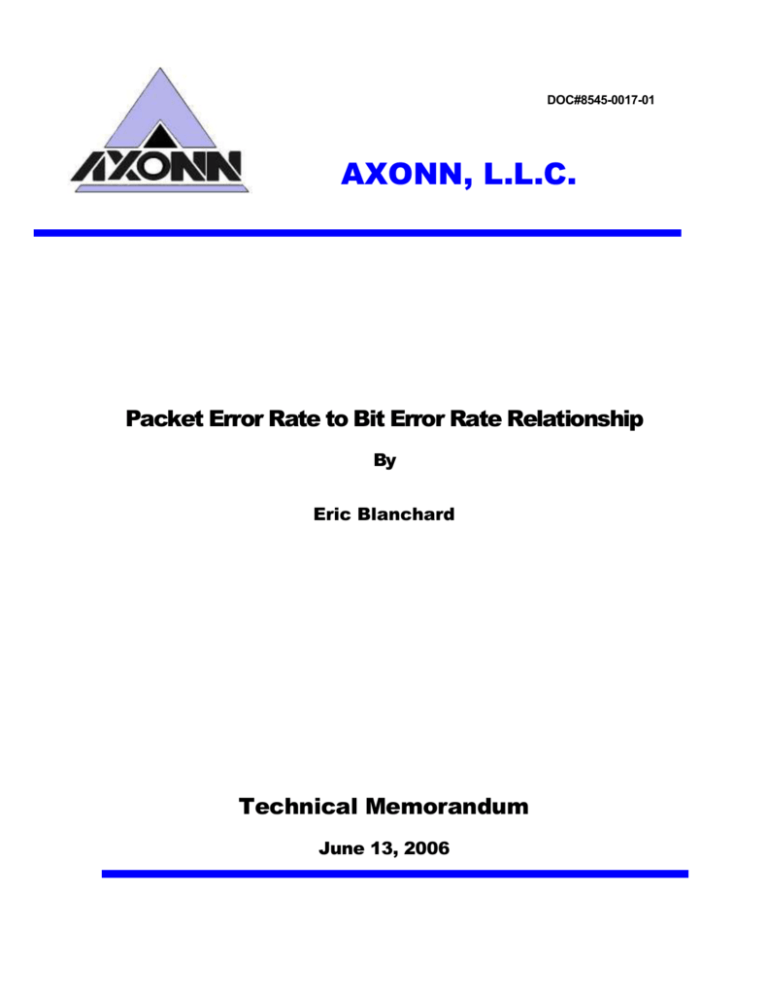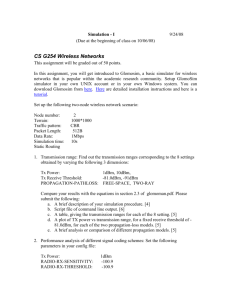PERtoBER
advertisement

DOC#8545-0017-01 AXONN, L.L.C. Packet Error Rate to Bit Error Rate Relationship By Eric Blanchard Technical Memorandum June 13, 2006 1. Introduction This document explains some of the mathematics behind relating a measured packet error rate value to an immeasurable bit error rate. In certain cases, it can be assumed that when an erroneous packet is received, there was only one bit that caused the error. However, for large packet sizes and/or error rates, the effects of multiple errors per packet must be taken into account. Three different methods of computing BER from PER will be examined and compared. 2. Test Program Parameters For the Stamp error and sensitivity testing, the packet size used in Ronnie’s test program is 128 bits per packet. The probability of 1 error occurring within that packet is 128*BER. There are 8128 combinations of having 2 errors in a packet and 341376 combos of 3 errors per packet. Since these combinations will be multiplied by their probability of occurring (BER^2 or BER^3), the lower the BER, the less of an impact those multiple error combos will have on the measured PER. 3. One Bit Error per Packet Assumption In the MMT throughput tests with the 2.4 GHz transceiver, there were packet success rates of 98.5%-99.1% at a distance of 200 feet out in the open. That means the PER was between 9.0*10-3 and 1.5*10-2. By assuming 1 bit error per packet, the resulting BER range is 7.0*10-5 to 1.172*10-4. 4. Effect of Adding One, Two, Three, and Four Bit Errors per Packet I decided to test the impact of including the possibilities of up to 4 errors per packet using the high end of the measured PER range (1.5*10-2). By setting the following equation equal to a PER of 1.5*10-2 and solving for BER, I found that a more accurate BER approximation is 1.162*10-4. PER=128*BER+8128*BER2+341376*BER3+10668000*BER4 This compares quite closely with the 1 error per packet assumption which yielded BER of 1.172*10-4. 5. Standard PER and BER relationship There is also a somewhat standard approximation formula in some journal publications and lecture notes that says PER=1-(1-BER)n where n is the packet size. Using that formula yields a BER range of 7.06*10-5 to 1.181*10-4. This seems to overestimate the BER slightly, but still within a reasonable amount. 6. Conclusion Although assuming 1 bit error per packet proved satisfactory for the given PER measurements and resulting BER approximations above, at a significantly higher bit error rate, say 0.1%, the probability of having 1 error in a packet of 128 bits is 0.128. If the possibility of 2 and 3 errors per packet is included, that raises the PER to: 0.128+8128*0.001^2+341376*0.001^3=0.1365 This is a fairly significant increase; so unless the packet size is decreased, care must be taken when deriving BER values from PER measurements near the sensitivity threshold of 0.1% BER at -90dBm. 1







